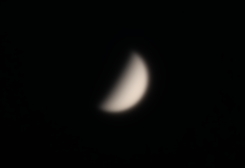Venus Filter Tests
Posted: 11 June 2023
In preparation for my "Ashen Light" observing attempts in June 2023, I did Venus observing and imaging tests using some of my various 1.25" and 2" filters. This article is a report on those tests, done on 3 June 2023, 4 June 2023, 6 June 2023, 7 June 2023, and 9 June 2023.
Visual Tests
1.25" filters on a 1.25" 5.5mm eyepiece (443X). Here are the results.
Light Reduction Filter (LPR): Good to reduce the glare from the bright planet. Shading near the terminator was evident.
#82 Light Blue: Very little effect.
#8 Light Yellow: Very little effect.
#56 Light Green: Reduced glare. Some near terminator shading visible.
#21 Orange: Very little effect.
Moon Filter: Reduced glare. Near terminator shading not as evident as with LPR filter.
Hydrogen-Beta: Considerable brightness reduction. Near terminator shading more pronounced.
2" filters on a 2" 5.5mm eyepiece (443X). Here are the results.
2" UHC: Reduced glare from the bright planet disk.
2" SII: Planet dimmed too much for visual use.
2" Hydrogen-Alpha: Too dim for visual use but better than SII.
2" OIII: Reduced glare from bright planet disk.
Variable Polarizing Filter 1 (VPF1): Nice reduction in the brightness of the planet's disk.
I rotated the eyepiece with the VPF1 attached to see if any polarization of the light from Venus could be detected. Nothing noticed.
I attached VPF2 to the star diagonal. I rotated the eyepiece with VPF1 attached to vary the amount of dimming of the planet's disk. Near maximum polarization provided a good view of shading near the terminator.
The 1.25" LPR and 2" VPF1 provided the best views of a half-illuminated Venus, 443X.
Photographic Tests
Mounted the D850 DSLR at prime focus + 2" 2X Powermate using a 2" to 1.25" adapter (to accept the 1.25" filters). Imaged Venus at various exposures using a White Balance of 4550K. The following images are cropped from the full-frame images, but otherwise are not edited.
No filter (1/400sec, ISO 400)

LPR (1/320sec, ISO 400)

#82 Light Blue (1/320sec, ISO 400)

#8 Light Yellow (1/250sec, ISO 400)

#56 Light Green (1/250sec, ISO 400)

#21 Orange (1/400sec, ISO 400)

Moon Filter (1/250sec, ISO 400)

Hydrogen-Beta (1/320sec, ISO 1600)

Mounted the D850 DSLR at prime focus + 2" 2X Powermate and did the following 2" filter test images, White Balance 4550K. The images are cropped from the full-frame images, but otherwise are not edited.
No filter (1/250sec, ISO 400)

UHC (1/250sec, ISO 400)

SII (1/250sec, ISO 4000)

HA (1/250sec, ISO 4000)

OIII (1/400sec, ISO 1600)

VPF1 (1/250sec, ISO 400)

For imaging, the 1.25" Moon filter and the 2" VPF1 filter provided the best images.
I also did a 1080p, 60fps, video recording, 1/400sec, ISO 400, of Venus, prime focus + 2X Powermate + VPF1. This is a stack of 1392 video frames.

Did a 1080p, 60fps, video recording of Venus, prime focus + 4X Powermate + Variable Polarizer Filter 1 (1/400sec, ISO 1600). This is a stack of 1366 video frames.

As Venus gets lower in the sky, using the ZWO Atmospheric Dispersion Corrector will be essential.
Comments are welcome using Email. Twitter users can use the button below to tweet this report to their followers. Thanks.
Cassiopeia Observatory Home Page
Copyright ©2023 Michael L. Weasner / mweasner@mac.com. Email Etiquette.
URL = http://www.weasner.com/co/articles/Venus_Filters.html
